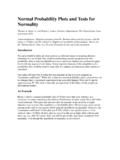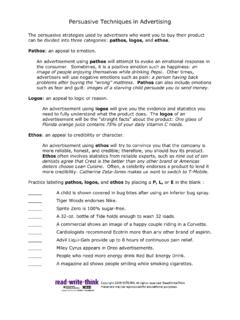Transcription of Getting Started with Minitab Statistical Software
1 Getting Started with Minitab StatisticalSoftwareContents1 Introduction4 Overview4 The story4 The Minitab user interface4 Data types6 Open and examine a worksheet7In the next chapter72 Graphing Data8 Overview8 Create, interpret, and edit histograms8 Create and interpret scatterplots13 Arrange multiple graphs on one layout16 Save a Minitab project19In the next chapter203 Analyzing Data21 Overview21 Summarize the data21 Compare two or more means23 Save the project29In the next chapter294 Assessing Quality30 Overview30 Create and interpret control charts30 Create and interpret capability statistics35 Save the project36In the next chapter365 Designing an Experiment37 Overview37 Create a designed experiment37 View the design40 Enter data into the worksheet41 Analyze the design and interpret the results42 Use the stored model for additional analyses45 Save the project48In the next chapter496 Repeat an Analysis50 Overview50 Perform an analysis using session Started with Minitab Statistical SoftwareCopy session commands51 Use an exec file to repeat the analysis52 Save the
2 Project53In the next chapter547 Importing and Preparing Data55 Overview55 Import data from different sources55 Prepare the data for your analysis57 When data values change60 Save the Started with Minitab Statistical Software1. IntroductionOverviewGetting Started with Minitab Statistical Software introduces you to some of the most commonly used features and tasksin : Some features in this guide are only available in the desktop app. When you use the web app, you can open the desktop app to accessall of the features that Minitab Statistical analyses require that you follow a series of steps, often directed by background knowledge or by thesubject area that you are investigating. Chapters 2 through 5 illustrate the following steps: Explore data with graphs and present results Conduct Statistical analyses Assess quality Design an experimentIn chapters 6 and 7, you learn to do the following: Use shortcuts to automate future analyses Import data into Minitab from different file types and prepare the data for analysisThe storyA company that sells books online has three regional shipping centers.
3 Each shipping center uses a different computersystem to enter and process orders. The company wants to identify the most efficient computer system and to use thatcomputer system at each shipping Getting Started with Minitab Statistical Software , you analyze data from the shipping centers as you learn touse Minitab . You create graphs and perform Statistical analyses to identify the shipping center that has the most efficientcomputer system. You then concentrate on the data from this shipping center. First, you create control charts to testwhether the shipping center s process is in control. Then, you perform a capability analysis to test whether the processis operating within specification limits. Finally, you perform a designed experiment to determine ways to improve also learn how to use session commands to automate future analyses and how to import data into Minitab user interfaceEverything you see in the Minitab interface is part of your Started with Minitab Statistical SoftwareThe Minitab interface includes the following components:1: NavigatorContains the list of output titles and report titles in your project.
4 The output and reports are sorted from oldest tonewest, with the most recent items at the bottom of the list. Right-click any title in the Navigator to do the followingtasks: Open the output or the report in split view to compare outputs and to easily drag and drop output into a report. Rename the output or the report. The name is also updated in the output pane. Send the output or the report to a different application, such as Microsoft Word, Microsoft PowerPoint, MinitabEngage , or Minitab Workspace . Delete the analysis or the report from the project. You can undo this action from the Edit : If your project has multiple worksheets, you can view the list of output by worksheet. From the Navigator, click and chooseGroup Commands by Worksheet2: Output paneDisplays a list of the output pages and report pages in a project. Output pages display output such as graphs ortables after you run an analysis.
5 Report pages display output that you collect from one or more output pages. Youcan create and edit reports in the desktop app. You can only open and view reports in the web app. From the outputpane, you can do the following tasks: To affect the contents of a tab, click the tab, then click next to the output title. To affect a specific table or graph, click the graph or the table, then click . Started with Minitab Statistical Software To view output that is not currently visible, click the title of the output in the : To compare the output of two different analyses or reports, right-click the second piece of output in the Navigator and chooseOpen in Split : Data pane (worksheets)Displays the active worksheet. You can have multiple worksheets in the data pane; however, Minitab uses the datain the active worksheet to run the : To rename a worksheet, double-click the name in the worksheet : Command Line/History paneBy default, this pane is not shown.
6 To show this pane, choose View > Command Line/History. If you close Minitabwhile the pane is visible, the pane is visible the next time you open LineThe location where you can enter or paste command language to perform an command language that Minitab uses to run an analysis. You can select and copy commands andsubcommands from the History pane to the Command Line pane, where you can edit and run them : Status barUse the status bar to show or hide the Navigator, the data pane, or the output pane. You can also zoom in or zoomout on a graph or a worksheet, depending on whether the data pane or the output pane is selected. Click to show or hide the Navigator. Click to show the output pane and the data pane at the same time. Click to show only the data pane. Click to show only the output typesA worksheet can contain the following types of dataNumbers, such as 264 or dataLetters, numbers, spaces, and special characters, such as Test #4 or North dataDates, such as Mar-17-2020, 17-Mar-2020, 3/17/20, or 17/03 , such as 08:25:22 , such as 3/17/20 08:25:22 AM or 17/03/20 08:25 Started with Minitab Statistical SoftwareOpen and examine a worksheetYou can open a new, empty worksheet at any time.
7 You can also open one or more files that contain data, such as aMicrosoft Excel file. When you open a file, you copy the contents of the file into the current Minitab project. Any changesthat you make to the worksheet while you are in the project do not affect the original data for the three shipping centers are stored in the worksheet, : In some cases, you need to prepare your worksheet before you begin an analysis. For more information, go to Importing and PreparingData on page the data set, data are arranged in columns, which are also called variables. The column number and name are at the top of 15:213/4 8:34 Eastern1196On 17:053/4 8:35 Eastern2299 Back order**3/4 8:38 Eastern3205On 15:523/4 8 14:483/4 8:42 Eastern5In the worksheet, each row represents a single book order. The columns contain the following information: Center: shipping center name Order: order date and time Arrival: delivery date and time Days: delivery time in days Status: delivery status On time indicates that the book shipment was received on time.
8 Back order indicates that the book cannot be shipped yet because it is not currently in stock. Late indicates that the book shipment was received six or more days after the order was placed. Distance: distance from the shipping center to the delivery locationIn the next chapterNow that you have a worksheet open, you are ready to start using Minitab . In the next chapter, you use graphs to checkthe data for normality and examine the relationships between Started with Minitab Statistical Software2. Graphing DataOverviewBefore you perform a Statistical analysis, you can use graphs to explore data and assess relationships between thevariables. Also, you can use graphs to summarize data and to help interpret Statistical can access Minitab s graphs from the Graph and Stat menus. Built-in graphs, which help you interpret results andassess the validity of Statistical assumptions, are also available with many Statistical graphs include the following features: Pictorial galleries to help you choose a graph type Flexibility in customizing graphs Graph elements that you can change Option to be updatedThis chapter explores the shipping data worksheet that you opened in the previous chapter.
9 You use graphs to checknormality, compare means, explore variability, and examine the relationships between , interpret, and edit histogramsBefore you perform a Statistical analysis, first create graphs that display important characteristics of the data. For theshipping data, you want to know the mean delivery time for each shipping center and how the data vary within eachshipping center. You also want to determine whether the shipping data follow a normal distribution, so that you can usestandard Statistical methods for testing the equality of a paneled histogramTo determine whether the shipping data follow a normal distribution, create a paneled histogram of the time lapse betweenorder date and delivery : When you use the web app, click Open in Desktop App to complete the following you are continuing from the previous chapter, go to step 2.
10 If not, open the data set, Graph > Started with Minitab Statistical With Fit, and then click Graph variables, enter Multiple Graphs, and then click the By Variables By variables with groups in separate panels, enter OK in each dialog :To select variables in most Minitab dialog boxes, use one of the following methods: Double-click the variables in the variables list box. Highlight the variables in the list box, and then click Select. Type the variables names or column Started with Minitab Statistical SoftwareHistogram with groups in separate panelsInterpret the resultsThe histograms seem to be approximately bell-shaped and symmetric about the means, which indicates that the deliverytimes for each center are approximately normally the paneled histogramFor the graph that you created, you want to rearrange the three panels so that comparisons among the means andvariations are : When you use the web app, click Open in Desktop App to complete the following the histogram to open the Edit Graph dialog any of the histogram titles (Central, Eastern, or Western) and choose Edit the Arrangement tab, in Rows and Columns, select Custom.


















